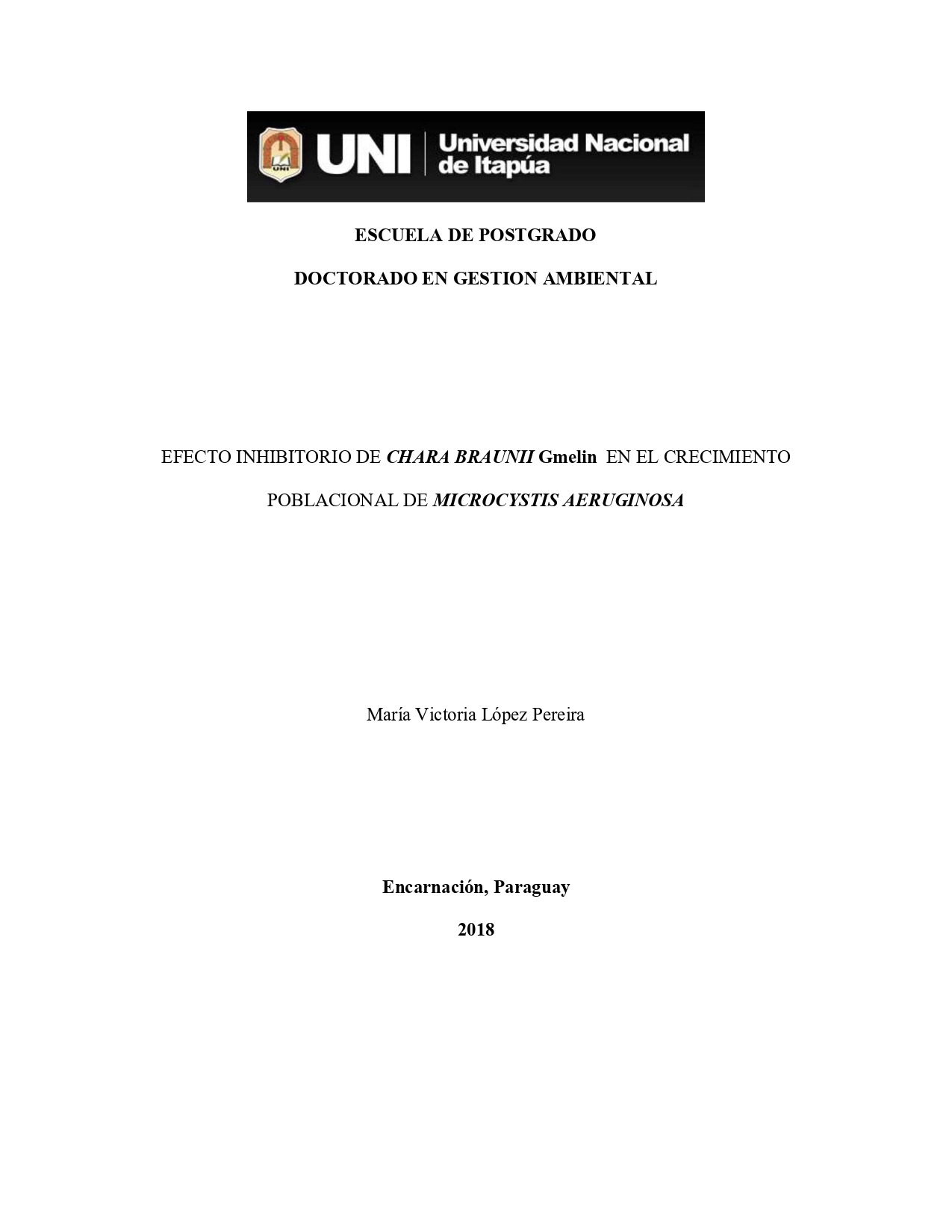Efecto inhibitorio de Chara Braunii Gmelin en el crecimiento poblacional de Microcystis aeruginosa
Compartir
Registro completo
Mostrar el registro completo del ítemAutor(es)
López Pereira, María VictoriaFecha de publicación
2018-11-17Tipo de publicación
info:eu-repo/semantics/doctoralThesisMateria(s)
Carófitos
Cianobacteria
Compuestos alelopáticos
Inhibición
Charophyta
Cyanobacteria
Allelopathic compounds
Inhibition
Cianobacteria
Compuestos alelopáticos
Inhibición
Charophyta
Cyanobacteria
Allelopathic compounds
Inhibition
Resumen
Esta investigación tuvo como objetivo analizar los efectos inhibitorios de Chara Braunii sobre el crecimiento poblacional de Microcystis aeruginosa. Para el logro de los objetivos específicos, 1) se realizaron colectas e identificación taxonómica de las especies, utilizando claves de identificación. Posteriormente, el aislamiento y cultivo de Microcystis aeruginosa utilizando 6 biorreactores y medio BG11 en dosificación de 2000 mL, dando como resultado que las condiciones de crecimiento ideales fueron temperatura promedio de 25 ± 3°C, PAR de 0,8086 µmol•s⁻¹•m⁻², fotoperiodo de 14:10, pH de 7,10 y agitación diaria. Con los datos de densidad, se aplicó el modelo Lokta-Volterra, los resultados indicaron que las estaciones de primavera y verano, se registró exclusión competitiva de Microcystis aeruginosa siendo Chara Braunii la de mayor competitividad espacial. 2) Por HPLC se determinaron los ácidos grasos de Chara Braunii, siendo los ácidos oleico, linoléico, palmítico y esteárico los de mayor porcentaje. 3) Se realizaron extractos de la macroalga, que fueron aplicadas al cultivo de la cianobacteria en dosificaciones de 3,5, 15 y 20 mL, calculando diariamente la concentración celular y rango inhibitorio. Se aplicó el análisis de varianza y comparación de medias por el método Fisher con lo cual se determinó que hubo una reducción de la concentración celular al 5to día de experimentación y una mayor inhibición de Microcystis aeruginosa aplicando la concentración de 20 mL del extracto, infiriendo que los compuestos alelopáticos de Chara Braunii podrían ser los ácidos grasos presentes en la planta. Se concluye que a mayor concentración del extracto de la macroalga, esta inhibe a Microcystis aeruginosa, siendo posible su aplicación en lagos u embalses que presenten floraciones algales de este tipo. The aim of this research was to analyze the inhibitory effects of Chara Braunii on the population growth of Microcystis aeruginosa. To carry out the specific objectives, 1) collections and taxonomic identification of the species were carried out, using identification keys. Followed by the isolation and culture of Microcystis aeruginosa using 6 bioreactors and half of BG11 in 2000 mL dosage, in which it was observed that the ideal growth conditions were the average temperature of 25 ± 3 ° C, PAR of 0.8086 μmol • s⁻¹ • m⁻², photoperiod of 14:10, pH of 7.10 and daily agitation. As for the density data, the Lokta-Volterra model was applied, the results indicated that during the spring and summer seasons, there was registered competitive exclusion of Microcystis aeruginosa being Chara Braunii; the one with the highest spatial competitiveness. 2) Chara Braunii fatty acids were determined by HPLC, being the oleic, linoleic, palmitic and stearic acids with the highest percentage. 3) Extracts of the macroalgae were carried out, which were applied to the cultivation of the cyanobacterium in dosages of 3.5, 15 and 20 mL, calculating daily the cell concentration and inhibitory range. The analysis of variance and comparison of measures was applied using the Fisher method, with which it was determined that there was a reduction in cell concentration on the 5th day of experimentation and a greater inhibition of Microcystis aeruginosa by applying the concentration of 20 mL of the extract, inferring that the allelopathic compounds of Chara Braunii could be the fatty acids present in the plant. It is concluded that a higher concentration of macroalgae extract inhibits Microcystis aeruginosa, being possible its application in lakes and reservoirs that have algal blooms of this type.






